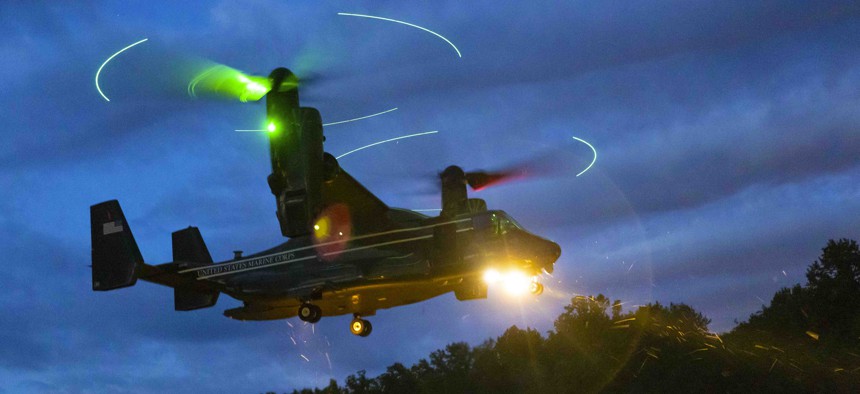
A Marine Corps MV-22 Osprey prepares to land during a squad competition at Marine Corps Base Quantico, Va., April 24, 2023. U.S. Marine Corps / Lance Cpl. Joaquin Dela Torre
Marines to appoint a safety general
After deadly crashes, acting commandant bumps Corps’ Safety Division up to one-star status.
The Marine Corps will place a general officer in charge of the service’s Safety Division next summer, the acting commandant announced Wednesday in the latest response to two deadly aircraft crashes.
The division is currently led by a colonel. (The Navy’s Safety Command is run by a rear admiral.) Bumping the Marine command up a paygrade will allow a one-star to “supervise it, to authoritatively direct it, and ensure that ruthless adherence to our culture of safety, that I think will matter,” Gen. Eric Smith told reporters on the sidelines of the Defense News Conference in Arlington, Virginia. “[H]aving that general officer in charge will help because general officers do matter. Because there's only 63 of us in service. And that means that they don't have to salute very many people and they don't take, frankly, any junk from anybody.”
The officer will still be “reporting to the assistant commandant [of the Marine Corps] but we will have a general officer in charge of safety. It's that important to me, and I think it's time to do that,” Smith said.
Like the other services, the Marine Corps is authorized a set number of general officers, so it's unclear at the moment where the general officer will come from to lead the division.
Last week, Smith called for a service-wide safety review after the deadly crashes of an F/A-18D Hornet near Marine Corps Air Station Miramar in California and an MV-22B Osprey in Australia, which are both still under investigation. Units will review and discuss their safety procedures, and junior Marines are also asked to “provide honest feedback on perceived hazards; they should expect to do so without fear of reprisal.” That feedback is due to the Safety Division by Oct. 15.
The Marine Corps’ Safety Division will grow with the new general officer, and while it will not be as large as the Navy’s, it will be a similar organization, Smith said.
“[I]t's high time we did that. And that shines a spotlight on our culture of safety, which is an exceptional culture of safety. And when we have a deviation from it, it stands out like a sore thumb,” Smith said. “And again, what I owe is to every Marine and their loved ones the absolute clarity that I have driven risk down to the lowest possible level I can drive it to.”
The division will also be “robust enough” to take the safety review’s findings from the junior Marines “and go out and either correct problems or reinforce good behavior in units that have exceptional safety records. To make sure that everything from weapons handling to vehicle maintenance to vehicle operation, to aircraft maintenance to aircraft operation, is exactly, as I always say, is ruthlessly adhered to,” he said.
The recent Osprey crash and the aircraft’s ongoing clutch engagement problem have raised concerns about its safe operation. Smith still believes that the Osprey is safe to fly, highlighting that its safety record per 100,000 flight hours is the same as “all major platforms.”
“If I thought for a nanosecond that the V-22 was an inherently unsafe platform, I would ground it. It's not. I am 100-percent convinced it's a safe platform, or I would have grounded it. And there's no evidence that tells me I need to do that,” he said.




